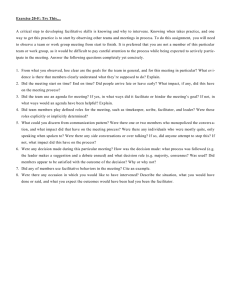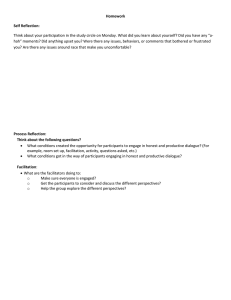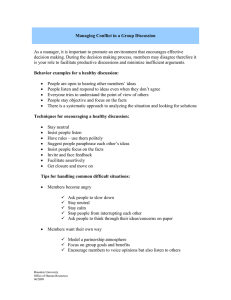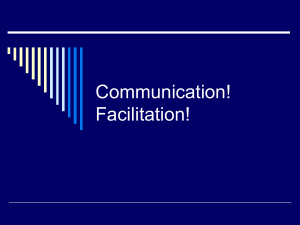The Role of the Facilitator in Faculty Learning Communities (FLCs)
advertisement
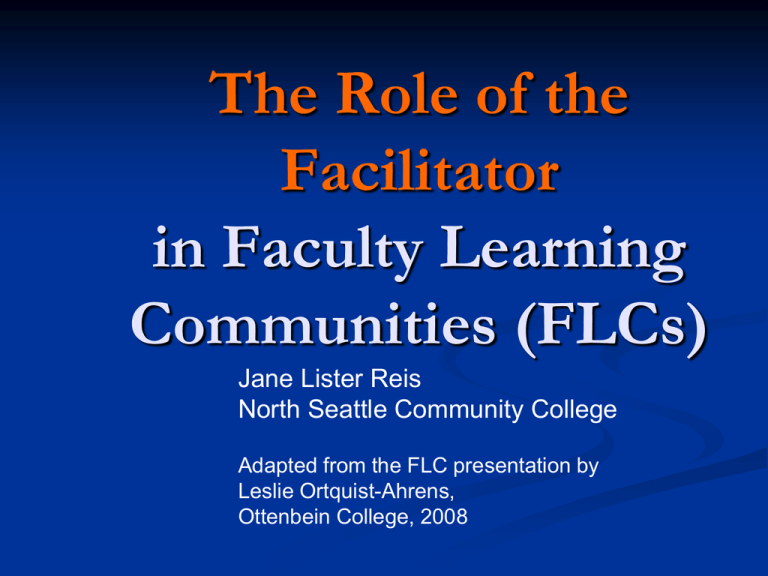
The Role of the Facilitator in Faculty Learning Communities (FLCs) Jane Lister Reis North Seattle Community College Adapted from the FLC presentation by Leslie Ortquist-Ahrens, Ottenbein College, 2008 Opening Reflective Question: What motivated you to go into higher education? The dream, the hope . . . Perhaps . . . Autonomy The life of the mind Intellectual community A place apart from the marketplace Love for your discipline A desire to teach and foster student growth Plain dumb luck . . . and the reality? Perhaps in addition to satisfactions . . . The pandemic of “busy-ness” Committee work Accountability pressures Exponentially expanding email volume University-as-business; student-as-customers Underprepared students Alienation, isolation, fragmentation, exhaustion What’s needed? Learning about an enormous variety of topics Long-term intensive and extensive development Genuine engagement with diverse colleagues Revitalized sense of academic community BUT: time is scarce and so is energy . . . One “solution": Faculty Learning Communities What faculty value: “Camaraderie” “Learning” “Sharing ideas” “Vital conversation” “Communication across campus” “Lasting friendships” “Confidence” “Safe environment “Connecting research for problem solving” and teaching” Main focus for this session Key responsibilities of facilitators Facilitative behaviors aptitudes and Challenges groups about working with Starting definition “‘Facilitation’ is a way of providing leadership without taking the reins. As a facilitator, your job is to get others to assume responsibility and take the lead” (Bens 2000). Facilitation key responsibilities 1. Administrative tasks 2. Planning / leadership 3. Group process Facilitation responsibilities… 1. Administrative tasks Structures, organization, logistics, supplies Move toward shared responsibility Facilitation responsibilities… 2. Planning / leadership Prepare and plan . . . but . . . Leave room for inquiry, members’ needs and interests, new directions Move toward shared planning and leadership Facilitation responsibilities… 3. Group process Set group goals and norms Attend to process as well as content Balance staying “on task” with latitude for exploration and fun (“learning as pleasure”) Shepherd group formation and dynamics Serve as a model and encourage facilitative behaviors in members Ten Necessary Qualities for Building Community --Milt Cox Safety and Trust Relevance Openness Challenge Respect Enjoyment Responsiveness Esprit de Corps Collaboration Empowerment What makes an FLC work? How can you cultivate the 10 qualities? Clear structures for meetings Nature of the “space” for meetings Regularity of meetings Mutual support Commitment on the part of members Cultivation of atmosphere/collegiality Inquiry-orientation Clearly defined, classroom-based projects Challenge Common topic for inquiry Projects (authentic) Willingness to challenge one another Rewards Appropriate facilitation 2. What are facilitative aptitudes and behaviors? The ideal facilitator QUESTION: Imagine you are writing a job description for a FLC facilitator. Based on what you’ve heard today about FLCs (or what you know from your own college’s experience), list: 2-5 things a facilitator should “be” 2-5 things a facilitator should “do” The ideal facilitator: “being” (attributes) PROCESS—coordinator—structure 23 21 CONTENT—champion—FLC focus, outcomes “organized” “sense of direction,” “goal orientation” “knowledgeable” “enthusiastic,” passionate about teaching/learning “curious,” “eager to learn” 17 16 RELATIONSHIPS—energizer—harmonizer, “soft skills” “listener” “open,” “non-judgmental” “assertive,” “firm,” “courageous” “motivator.” “personable” 46 77 The ideal facilitator: “being” (attributes) “intellectual humility” “emotional generosity” --2007 institute participant The ideal facilitator: “doing” (tasks/responsibilities) PROCESS Provide structure Keep group on task Create a safe but challenging environment (where people feel respected but not necessarily comfortable) Give voice to all participants (ensure no “time hogs”) CONTENT Bring background knowledge of topic Help scaffold experience for faculty Conclusions? 1. Successful facilitation requires great attention to individuals, interpersonal relationships, and group dynamics. 2. Successful facilitation relies more heavily on skillful attention to organization and process than on content knowledge. Simple definition: In essence, facilitation involves helping groups function well so members can achieve their common goal(s). sounds simple. . . but not easy. 3.Challenges (and some basics about FLCs and group process) Challenge #1 we’re tempted to make FLCs into some other kind of group CAT exercise: Defining Features Matrix Make a list of associations you have with the word “committee” Faculty and staff elsewhere have said: Committees PLCs Bureaucratic + - Cross-disciplinary group + + Chance to grow and learn - + Regular meetings + + Agenda + + Chance to explore - + Charge + - Boring + - Minutes + -? Creative / personally meaningful - + Chair does the work + - Comparison Both Committees FLCs Crossdisciplinary group Regular meetings Agenda Bureaucratic Chance to grow and learn Charge + minutes Boring Chance to explore Creative Outside work Chair does work Personally meaningful Some other things a faculty learning community isn’t A committee A self-study group A book club A writing group A taskforce A seminar Nor . . . A gripe session A social club An encounter group, or The 12 steps for bored academics Challenge #2 people are so great . . . except when they’re not (e.g when they’re hard to work with, annoying, etc.) Challenge #2 or: members’ work style preferences can (and probably will) collide Four corners exercise Structure Thinking Action People Consider what it’s like to work from your preferred mode or “corner” in a group. How would you try to convince those in other corners that yours is the best place to start? Conflict? Complement? What’s involved in facilitating? REMINDER: 1. PROCESS Organization, planning, logistics long-term planning structure + action 2. CONTENT (learning, project, outcomes) Shepherding / overseeing / encouraging the learning and project work thinking + action 3. RELATIONSHIPS (community) Supporting individuals, monitoring group process, and facilitating group dynamics people Getting started: sample first steps (process) Schedule regular meetings and develop calendar of target deadlines for projects (content) Develop list of potential readings, activities, experts, etc. before first meeting (relationships) Build community already in the first meeting (signal that this is something “different”) Challenge #3 Communicating and listening Communication strategies and skills Pose open questions Paraphrase and summarize Engage in active listening Reframe “Direct traffic” Restate / clarify group’s purpose; foreground emerging norms etc. Challenge #4 Inside / outside roles: participant-member member facilitator Facilitative responses (Kelsey and Plumb 2004) Walking the fine line: facilitator/member Define your roles and name them Encourage all to participate and check in with those who don’t agree Watch for times you are not perceived as neutral Withhold your opinion or vote until the group first has a chance to explore Challenge #5 groups are complex and dynamic Group formation / team stages Forming —initial coming together, optimism, some Storming —conflict, disagreement about project, feeling of Norming —conscious coming together to recommit and Performing —energized period of making progress toward nervousness about acceptance “going in circles,” doldrums define common project and process project goals Facilitative responses Forming Structure early meetings carefully Set a tone of openness, inclusiveness, empowerment, trust, comfort Encourage involvement of all members; manage participation Clarify expectations; invite goal-setting and development of norms Facilitative responses (Bens 2000) Storming Expect and accept tension as normal Stay totally neutral and calm Create an environment where people can safely express feelings Honestly and openly admit that there’s conflict Help members identify issues and solve them together Assertively referee heated discussions Facilitative responses (Bens 2000) Norming Encourage problem identification and problem solving Invite input and feedback Support members while they make improvements Further share power Mediate personality clashes Coach and counsel individuals Encourage others to take on leadership roles Facilitative responses (Bens 2000) Performing Collaborate with members on meeting designs to get their input Share facilitation duties Offer expertise to the team Help team reward and celebrate success Offer to observe and give feedback to further improve the team 4. Questions? Go places, stretch yourselves, learn, be mindful, have fun . . . Blitzman (CC)
